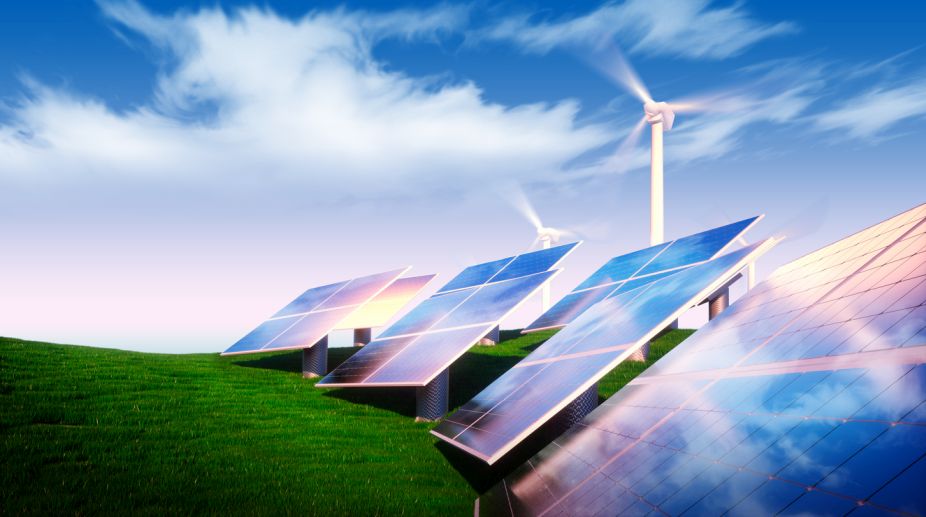Bangladesh portraying India negatively, New Delhi tells Dhaka
The Bangladesh envoy was told that the comments attributed to Bangladesh former Prime Minister Sheikh Hasina have been made in her individual capacity in which India has no role to play.

Representational Image. (Photo: Getty Image)
The Ministry of New and Renewable Energy (“MNRE”) has been taking several steps to ensure a clean energy future for the country. As part of its year-end review, the Ministry declared its plans of coming up with the largest renewable capacity expansion programme in the world.
As a part of India’s pledges to the Paris Agreement in December 2015, the Government is aiming to increase its share of clean energy, with an added emphasis on renewable energy. Such a step is guided by its pledge to increase the share of non-fossil based energy resources to 40 percent of installed electric power capacity by 2030.
Advertisement
Current statistics are reflective of the fact that renewable sources do not contribute much to the total energy supply and electricity supply of the country. Out of 6,41,423.39 KToe of total primary energy supply as of 2015-16, coal is the highest contributor to energy supply at 53.9 percent, followed by crude oil at 35.5 percent and natural gas at 7.38 percent (Centre Statistics Office, Ministry of Statistics and Programme Implementation 2017).
Advertisement
Supply of energy from renewable sources such as hydro power stands at 1.54 per cent and from solar, wind and other similar sources stands at 5.24 per cent. Energy supply from nuclear sources stands at 1.44 per cent. The above data clearly proves that renewable sources are contributing a mere 6.78 per cent towards the country’s energy supply.
A similar pattern is witnessed when one looks at the sources of electricity generation in the country. Coal again tops the charts with a 76.71 percent contribution towards Gross Electricity Generation in India as of 2015-16 (Central Electricity Authority, Ministry of Power 2016). Surprisingly, hydropower follows coal with a 10.39 percent contribution.
Then comes renewable energy sources at 5.36 percent, natural gas at 4.03 percent, nuclear power at 3.20 percent and diesel at 0.03 percent. The total contribution of all renewable energy sources to gross electricity generation stands at 15.75 percent. On the other hand, the contribution of renewable energy sources to all India installed generating capacity stands at 28.34 percent.
Thus, although we may be successfully proceeding towards our pledge under the Paris Agreement, we are still far behind in terms of using generating capacity towards actual generation and supply of electricity.
The government is trying its best to promote the adoption of renewable energy sources by coming up with different incentives such as generation-based incentives, sector-wise incentives, concessional finance, subsidies etc.
The National Solar Mission is one such initiative of the government aimed at promoting the development and use of solar energy for power generation and other uses. The main aim of the mission is to make solar energy a viable alternative for conventional energy options.
The mission plans to achieve these objectives by reducing the cost of solar power generation in the country through long-term policy, large-scale deployment goals, aggressive R&D and the domestic production of critical raw materials, components and products.
The Government is evidently inclined towards transitioning the energy supply side scenario in India. The energy choices in the country will progressively become governed by INDC commitments, long-term sustainability, enhanced electricity access, reliability of power, and, environmental and social considerations. The tightening of environmental norms is also in the pipeline.
However, all these developmental activities must be undertaken very carefully and after proper assessment of our administrative and technological capacities. The Indian electricity sector is constantly witnessing a major transformation in respect of demand growth, energy mix and market operations, due to various socio-economic, demographic and technological changes in the landscape. In such a situation, it is of utmost importance that a detailed and critical assessment of the emerging scenario be carried out for sustainable growth of this sector.
Also, a major shift to renewable sources of energy will be immensely challenging on grounds of planning and operation of power systems. Detailed research carried out by The Energy and Resources Institute (“TERI”) confirms that a number of key developmental challenges could be roadblocks in the process towards sustainability in energy supply.
These challenges include timely strengthening of the grid infrastructure, provision of adequate balancing and storage capacity, improved forecasting of renewable energy power as well as demand and improved financial health of utilities.
TERI also suggests that under the approaching scenario, annual assessments are necessary to take stock of the emerging situation by evaluating the evolving demand and supply trajectory, technological developments and learning from global experiences.
The above guidelines must be kept in mind by the Government for a smooth transition into sustainable energy supply. However, the major question that remains unanswered is that even if enough generating capacity is ensured, will that capacity translate into actual generation and supply of energy and electricity?
Also, are we ready to undertake all the above-mentioned steps to change the energy mix of the nation, or will we, like always, get stuck in the vicious cycle of administrative unpreparedness and non-implementation of policies?
The writer is a final year law student at the Jindal Global University, Sonipat.
Advertisement